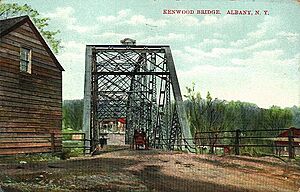Kenwood, Albany, New York facts for kids
Quick facts for kids
Kenwood
|
|
|---|---|
|
Hamlet
|
|
| Country | United States |
| State | New York |
| Region | Capital District |
| County | Albany |
| Settled | 1618 |
| Elevation | 32.8 ft (10.0 m) |
| Time zone | UTC-5 (EST) |
| • Summer (DST) | UTC-4 (EDT) |
| ZIP Code |
12209
|
| Area code(s) | 518 |
Kenwood was once a small community, often called a "hamlet," located in the Town of Bethlehem, New York. It was found on both sides of the Normans Kill creek, close to where this creek flows into the big Hudson River. Over the years, some northern parts of Kenwood were added to the nearby city of Albany, New York in 1870 and again in 1910.
History
Kenwood, which was also known as Lower Hollow or Rensselaer's Mills, has a long history. It dates back to the very first Dutch settlers in the area now called New York's Capital District.
Early Days
In 1618, the Dutch built a fort along a creek. The native people called this creek Tawasentha. This new fort replaced an older one from 1614 on Castle Island. The old fort had been lost due to yearly floods along the Hudson River.
In 1637, a man named Albert Andriessen Bradt built a mill there. Bradt was from Norway and was nicknamed "the Norman". Because of him, the Tawasentha creek was renamed Normans Kill.
The area known as Lower Hollow, which later became Kenwood, was part of a large estate called the Manor of Rensselaerswyck. After the US Revolutionary War, the owner, Van Rensselaer, had several mills built here.
Growth and Changes
In 1804, a company was formed to build a turnpike (a road where you pay a toll to use it). This road went from Albany through Lower Hollow. It then split into two paths. One path went to Babcocks Corners and the other to The Abbey. A man named Robert Van Rensselaer lived in a house near the bridge where the turnpike crossed the Normans Kill.
A businessman named Joel Rathbone bought a large, wooded area of about 1,200 acres (4.9 km²). In 1841, he built a grand Gothic mansion for his retirement. He named his estate "Kenwood" after a place in his home country of Scotland. Soon, the whole area around his estate became known as Kenwood too.
In 1863, the Albany and Susquehanna Railroad opened. It ran through Kenwood on its way to other towns like Delmar and Binghamton. Kenwood became an important spot called Kenwood Junction. This is where the West Shore Railroad and the Albany and Susquehanna lines met.
Over time, the Albany and Susquehanna line was taken over by the Delaware and Hudson Railway. Later, the Canadian Pacific Railway (CP) bought it in 1990. In 2000, CP stopped using the line from Kenwood to Voorheesville because of concerns about a bridge.
In 1870, the city of Albany took over a part of Kenwood, including Rathbone's estate. In 1886, Kenwood had 16 homes, a school, a store, a blacksmith, and a church. About 150 people lived there.
In 1910, Albany took over even more of Kenwood, specifically the land north of the Normans Kill creek. This made the creek a natural border between Albany and Bethlehem. The schoolhouse on the north side of the creek became part of Albany.
In 1916, a new highway called Southern Boulevard (US Route 9W) was built. This road bypassed Kenwood, connecting Albany to the turnpike in Bethlehem. In the early 1930s, a new path for South Pearl Street (New York State Route 32) was built. This new road also meant that much of the old turnpike route through Kenwood was no longer used. Roads on the Bethlehem side ended at the Normans Kill.
As of February 2020, Kenwood is no longer officially recognized as a hamlet within the Town of Bethlehem.
Kenwood Academy
In 1859, a Catholic school called the Female Academy of the Sacred Heart bought the Rathbone estate. This included the mansion and about 53 acres (21 hectares) of land. In 1867, they tore down the mansion but used its materials to build a new church on the property. New school buildings were also constructed. Even President-elect Grover Cleveland visited the campus in 1884. The school later changed its name to the Kenwood Academy.
In 1975, Kenwood Academy joined with another school, the Episcopal St Agnes School. The new school was named the Doane Stuart School. It continued to use the Kenwood campus for many years. However, in 2009, the Doane Stuart School moved to a new campus in Rensselaer, New York.
After the Doane Stuart School left, the former Kenwood Academy campus, which was about 74 acres (30 hectares), was put up for sale in 2009. In 2010, a group called the Preservation League of New York State listed it as one of its "Seven to Save" endangered historic sites.
The property was sold in 2017. The buyer planned to turn it into a condominium complex (a building with many apartments). However, the project was not finished, and the property faced financial trouble. On March 23, 2023, the building caught fire and was almost completely destroyed. It was later torn down.
Famous residents
- Winifred Goldring (She was the first female State Paleontologist of New York, meaning she studied fossils and ancient life for the state.)




